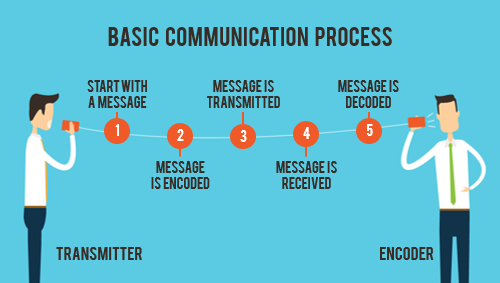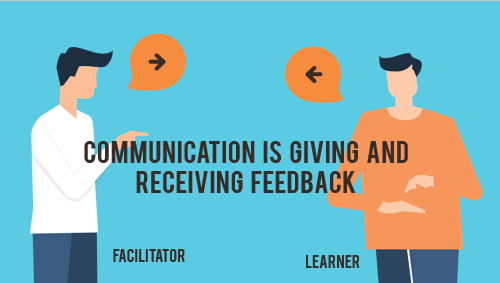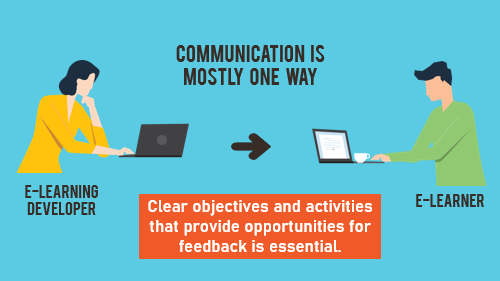How the Communication Process Impacts E-Learning
Author:
Go to Source

Effective e-learning is more than putting together screens of information and presenting them to learners. Instead it’s a process of curating content and then communicating it in a way that the learner understands and ultimately can apply.
The challenge sometimes rests in how the content is communicated, which then determines the level of understanding for proper application.
In a previous post, we did a quick overview of some of the challenges with communication and how to overcome them. Today, I’d like to take a quick look at the basic communication process and how that impacts what we do with our online course design.
Overview of the Communication Process

Here is the basic communication process.
- Generally, there’s a message and this has to go from one person to the other.
- The first person encodes the message into something that the other person can receive.
- The message is transmitted via some medium.
- The message is received and decoded.
- And the process flips and repeats itself between encoding, transmission, and decoding.
Hopefully what’s communicated is clear. If not, the process of going back and forth establishes clarity.
How Does the Communication Process Impact E-Learning
In a facilitated learning environment, the facilitator presents content. The learner receives it. If there’s some dissonance between the encoding and decoding, it’s easy enough to reconcile it.

Generally the facilitator can tell if there’s some confusion and the learner has plenty of opportunity to ask for clarification when things aren’t understood. There’s a lot of give and take.
This becomes a problem with most e-learning courses since they tend to be pushed out to the learner, usually with no opportunity to seek clarification. Because of this, it’s important to consider the content and how to assess the learner’s understanding through the course so that you can provide the appropriate feedback.

This is the point where many courses fail. Many organizations build courses heavy on information delivery and light on true assessment. And I don’t mean end-of-course quiz assessments. I mean continual assessment throughout the course to gauge the learner’s understanding of the content and with the right type of feedback.
Opportunities to Enhance the Communication Process for E-Learning

Here are a few quick thoughts on how to enhance the communication of the content and make up for places where there’s no back and forth.
- Content needs to be meaningful. Review the course content and structure it so it makes sense to the learner. This can happen with clear objectives and placing the content in a relevant, real-world context.
- Create meaningful activities. Step away from just content delivery and focus on meaningful and relevant learning activities. I like a backwards design approach. What does the learner need to do? Then design activities for them to prove they can do it. They may need to practice first; so design practice activities where you can assess their understanding and provide feedback. And then somewhere in that process, you construct the right content. This is better than a massive information dump.
- Account for barriers to effective communication and learning. Determine what obstacles exist between delivering and receiving the content. Many courses are text heavy and miss the opportunity to provide more memorable experiences with good visual support. And as noted above, many courses also lack relevance to the learner. This is often the case with compliance training, which drives a lot of e-learning. Find ways to engage them with meaningful activities where they get to practice using the content and acquire the right feedback.
E-learning often has the challenge of mostly one-way communication, so it’s important to build the right mechanisms in the course to ensure the learner is learning and has ample opportunity for feedback.
What are some things you do?
Download the fully revised, free 63-page ebook: The Insider’s Guide to Becoming a Rapid E-Learning Pro
Upcoming E-Learning Events
- April 20 & 21 (Brisbane). Articulate Roadshow: Learn more and register here.
- April 23 & 24 (Melbourne). Articulate Roadshow: Learn more and register here.
- November 9 &10 (London). Details coming soon.
Free E-Learning Resources
 |
 |
 |
|
Want to learn more? Check out these articles and free resources in the community. |
Here’s a great job board for elearning, instructional design, and training jobs |
Participate in the weekly elearning challenges to sharpen your skills |
 |
 |
 |
|
Get your free PowerPoint templates and free graphics & stock images. |
Lots of cool elearning examples to check out |
Getting Started? This elearning 101 series and the free e-books will help. |
